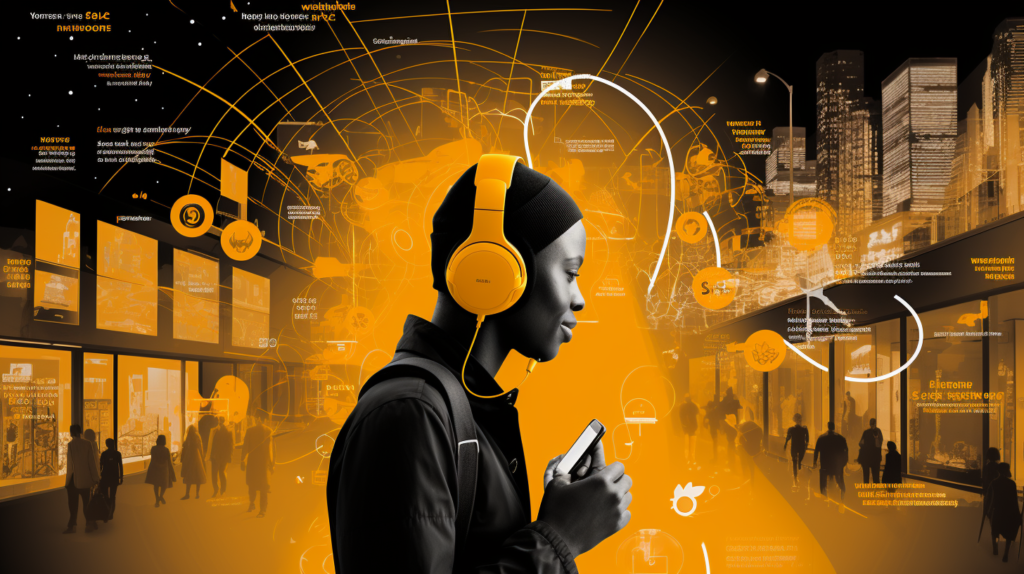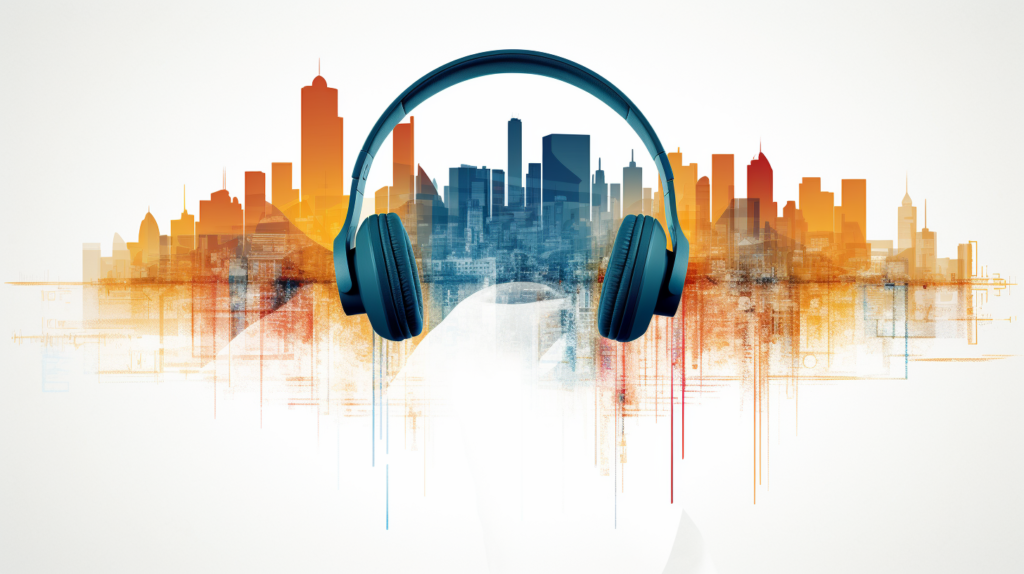Whether on a crowded subway or buzzing coffee shop, have you ever tried listening to music but found outside noise constantly breaking your focus?
Soundproof headphones absorb external noise and prevent internal audio leakage using specialized padding, noise canceling circuitry, and closed-back earcup designs that block distractions.
Let’s dive in to explore how the technologies built into soundproof headphones enable them to mute real-world distractions for deeper focus and listening enjoyment.
What Are Soundproof Headphones?

Soundproof headphones are listening devices engineered to absorb external noise and contain internal audio leakage using advanced technologies that enable the wearer to immerse themselves in pristine, uninterrupted audio reproduction.
Also referred to as noise-isolating or noise-cancelling headphones, they utilize a combination of physical design elements and electronic circuitry to block ambient sounds from entering the ears while preventing music, calls, media playback.
The aim of soundproof headphone engineering is to envelop the listener in a cocoon of silence, isolating them from the bustling sensory cacophony of everyday life.
The tightly sealed earcups and active noise cancellation work together to mute external distractions, creating a private listening space even in noisy environments.
This allows the wearer to delve deeply into music, podcasts, movies and other media without disruption from chatter, engine rumble, construction clamor or other distracting sounds nearby.
Some examples of situations where soundproof headphones excel include blocking out crowd noise on an airplane, keeping conversations private while working in a crowded office.
Providing isolation to allow focus while studying in a bustling college library, or preventing music leakage to maintain courtesy for others when listening loudly on public transit.
By forming both a physical barrier and using electronics to tune out ambient noise before it reaches the ear, the headphones allow audio to be enjoyed free of real-world distractions.
Soundproof headphones achieve this through carefully engineered design that differentiates them from standard headphones. Most regular headphones utilize an open-back design.
This allows sound waves to pass openly through the earcup driver. While this creates a more spatial, multi-dimensional listening experience, it also allows external noise in.
Soundproof headphones instead employ a closed-back design. The earcups completely surround the ears with padded cushions that form an acoustic seal.
This blocks outside noise from entering while containing the audio playback inside, away from bystanders.
Specialized padding in the cushions like memory foam also absorbs audio vibrations instead of resonating them. Finally, many soundproof headphones include active noise cancelling circuitry.
This uses external microphones to measure incoming noise, then produce inverse sound waves that electronically cancel out the surrounding ambient sounds through destructive interference before they reach the listener’s ear.
How Do Soundproof Headphones Block Out Sound?

Soundproof headphones employ several complementary technologies working in tandem to achieve isolation from external distractions and prevent audio leakage out.
The first and most basic tactic is the physical barrier formed by the closed-back earcups and padding pressed firmly around the ears to form a seal.
The earcups completely enclose the pinna, or outer ear, in a closed circumaural ring designed to obstruct the entry of sound waves into the ear canal. This prevents ambient noise from entering from the surrounding environment.
The earcups are lined with padding made of materials specifically selected for superior sound dampening properties, such as memory foam, synthetic protein leather, velour, or soft silicone.
The padding compresses when the headphones are worn to create a tight acoustic seal around the ear. This helps prevent sound leakage out of the headphones that could potentially disturb bystanders.
In addition to the passive noise isolation provided by the physical barrier of the earcups and padding, many soundproof headphones models also employ electronic active noise cancellation (ANC).
This technology uses a set of tiny microphones integrated into the structure of each earcup, positioned to pick up ambient environmental sounds around the wearer.
Common external noises include the drone of airplane engines, rumbling traffic, the hum of refrigerators, chatter in crowds, and the like.
The ANC circuitry analyzes the incoming noise signals from the microphones.
It mathematically determines the inverse sound waves needed to counteract them through destructive interference, then generates canceling frequencies back through the headphones’ drivers.
This has the effect of silencing external low frequency droning and rumbling sounds before they reach the ear canal and disrupt listening.
By combining both physical insulation and electronic canceling, total ambient noise entering the ears can be reduced by over 90% compared to regular headphones.
Some models also employ volume limiters that restrict and modulate amplification levels to a preset safe threshold.
This prevents damage to hearing from excessive volume while still allowing the noise isolation to deliver pristine audio clarity undiluted by competing ambient noise.
Together, these technologies allow soundproof headphones to mute the outside world completely for unbroken listening enjoyment.
Key Components That Enable Soundproofing

There are several integral components engineered into quality soundproof headphones that enable them to effectively seal out external noise and contain internal audio:
Closed-back earcups form a physical barrier around the ears, preventing sound waves from entering externally while also stopping sound leakage out. Circumaural designs that surround the ear block more noise than supra-aural earpads resting atop the ear.
Solid cup materials like hardened plastics or lightweight metals minimize acoustic vibration and resonance that could cause audio distortion. Open-back earcups would allow too much ambient noise in.
Padding density, thickness and material affects isolation capability. Multi-layered memory foams, protein leather and synthetic velours absorb audio vibrations most effectively.
Softer silicones can also conform tightly to seal irregular ear shapes. High density foams isolate better than thinner padding.
Feedback microphones integrated into the earcup shells supply the active noise cancelling circuitry with the ambient noise signal input needed to generate inverse canceling waves that reduce droning sounds electronically through phase cancellation before they disturb listening.
Volume limiters refine and modulate amplification to optimal levels that protect hearing while preserving audio clarity and preventing sound leakage at louder volumes. This lets noise isolation deliver pristine playback.
Rigid headband and earcup materials like composites, metal alloys and hardened engineering-grade plastics minimize acoustic resonance and prevent distortion for superior playback fidelity resembling studio reference monitors.
Taken together, these components enable soundproof headphones to reduce up to 95% of incoming and outgoing noise for unparalleled sound isolation capability.
Benefits of Soundproof Headphones

There are numerous benefits that make soundproof ANC headphones advantageous over standard open-back models:
Concentration – The electronic and physical noise reduction allows you to remain focused without disruptive ambient noises interrupting your task or entertainment, whether work, study or relaxation.
Hearing Protection – Volume levels can be calibrated to safer ranges without sacrificing audio clarity, preventing noise-induced hearing loss over long-term use.
No Disturbance of Others – Containing sound leakage prevents disrupting those around you – whether colleagues in a shared work space or fellow passengers on a train or plane.
Immersive Listening – The tight seal and noise cancellation enable deeper immersion in music, movies, games and calls without distraction from ambient noises that might break the experiential spell.
Privacy – Sound isolation provides confidentiality when listening to calls, recordings or content in public spaces since others can’t overhear.
Portability – Collapsible on-ear and over-ear models fold into compact forms for convenient portability on-the-go.
Comfort – Carefully engineered headband and earcup pressure distribution prevents discomfort over extended listening periods.
Taken together, these benefits make soundproof ANC headphones the ideal choice when seeking unbroken concentration, privacy and total tonal immersion without real-world distractions impeding your listening experience.
As audio reproduction technologies continue advancing, headphones with soundproofing deliver an increasingly sophisticated and customizable listening experience for discerning audiophiles in almost any environment.
Conclusion
With their ability to isolate listeners in a private audio oasis, soundproof headphones provide tangible benefits over standard models across a variety of use cases.
Their combination of physical insulation and electronic noise cancellation allows you to remain focused, protected, and undisturbed in environments from crowded offices to airplane cabins.
The audio reproduction clarity and discretion they enable is ideal for everything from portable music listening to keeping calls confidential.
While advancements will continue improving noise reduction capabilities, currently available soundproof headphones already deliver an immersive sonic experience free of ambient distractions.
For those seeking unparalleled focus, discretion and fidelity from their portable listening gear, these headphones represent the pinnacle of purpose-built design.
The isolation they provide lets audio be enjoyed in its pure form, bringing you closer to creators’ intended listening experience and free of real-world disruption.
